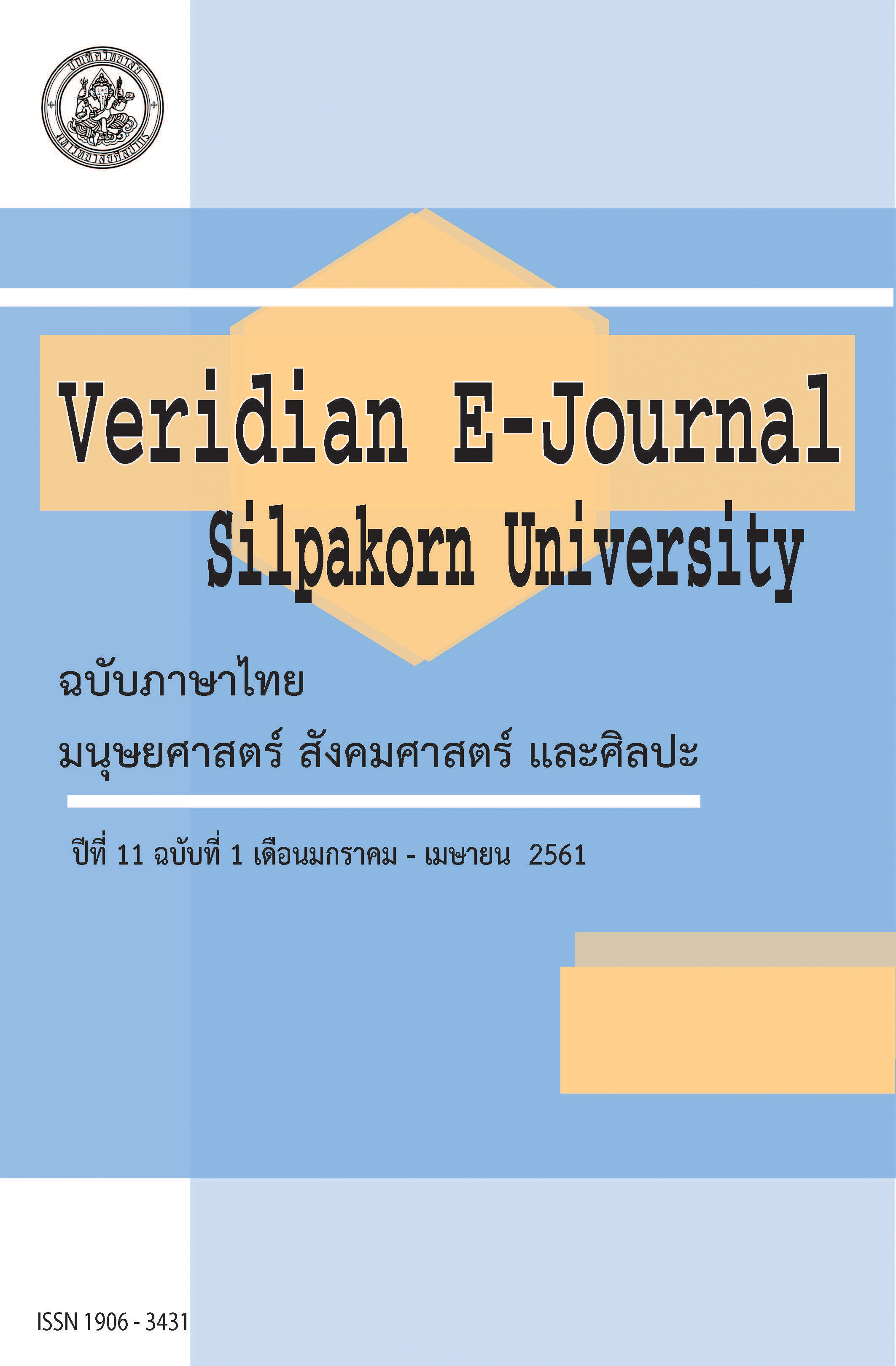รูปแบบการพัฒนาศักยภาพทางดนตรีของนักศึกษาโดยการเรียนรู้แบบร่วมมือพี่สอนน้อง (The Model of Students' Musical Potential Development Using Cooperative Learning by Peer Teaching Method)
Main Article Content
บทคัดย่อ
การวิจัยครั้งนี้มีวัตถุประสงค์หลักคือ สร้างรูปแบบการพัฒนาศักยภาพทางดนตรีของนักศึกษาโดยการเรียนรู้แบบร่วมมือพี่สอนน้อง ซึ่งมีวัตถุประสงค์ย่อยตามขั้นตอนดังนี้ 1) ศึกษาสภาพ ปัญหา และแนวทางในการจัดการเรียนรู้ทางดนตรี 2) สร้างและตรวจสอบรูปแบบการพัฒนาศักยภาพทางดนตรีของนักศึกษาโดยการเรียนรู้แบบร่วมมือพี่สอนน้อง 3) ศึกษาผลการใช้รูปแบบการพัฒนาศักยภาพทางดนตรีของนักศึกษาโดยการเรียนรู้แบบร่วมมือพี่สอนน้อง และ 4) ประเมินรูปแบบการพัฒนาศักยภาพทางดนตรีของนักศึกษาโดยการเรียนรู้แบบร่วมมือพี่สอนน้อง ดำเนินการตามระเบียบวิธีวิจัยและพัฒนา กลุ่มตัวอย่างในการวิจัยมี 2 กลุ่มคือรุ่นพี่ผู้สอนจำนวน 25 คนและรุ่นน้องผู้เรียนจำนวน 21 คน ซึ่งได้จากการสุ่มอย่างง่ายและใช้แบบแผนการวิจัยแบบ One Group Pretest – Posttest Design ระยะเวลาในการทดลองรูปแบบ 6 เดือน กิจกรรมดนตรีที่นำมาใช้มี 7 กิจกรรมได้แก่ 1) เพลงภาษาไทยสำหรับเด็กปฐมวัย 2) เพลงภาษาอังกฤษสำหรับเด็กปฐมวัย 3) คำกลอนประกอบจังหวะ
4) การตีกลอง 5) เกมประกอบจังหวะ 6) การเคลื่อนไหวและจังหวะ และ 7) กิจกรรมเตรียมเด็กให้สงบ พร้อมทั้งแผนการจัดกิจกรรม เครื่องมือในการเก็บข้อมูลมี 2 ชุด ชุดที่ 1 สำหรับประเมินศักยภาพทางดนตรีแบ่งเป็นของรุ่นพี่ผู้สอน ได้แก่ 1) แบบทดสอบความรู้ทางดนตรี 2) แบบประเมินพฤติกรรมความสามารถในการจัดกิจกรรมดนตรี และ3) แบบประเมินเจตคติที่มีต่อกิจกรรมดนตรี และของรุ่นน้องผู้เรียนได้แก่ 1) แบบทดสอบความรู้ และ 2) แบบประเมินศักยภาพทางดนตรีของนักศึกษา ชุดที่ 2 สำหรับประเมินรูปแบบฯ ได้แก่ แบบประเมินความคิดเห็นที่มีต่อรูปแบบฯ และการเขียนสะท้อนคิด วิเคราะห์ข้อมูลเชิงปริมาณโดยการหาค่าเฉลี่ย ส่วนเบี่ยงเบนมาตรฐาน และการทดสอบค่าที วิเคราะห์ข้อมูลเชิงคุณภาพ ได้แก่ การจับกลุ่มข้อมูลประเด็นหลัก และวิเคราะห์สรุปอุปนัย
ผลการวิจัยมีดังนี้
- สภาพปัญหาการจัดการเรียนรู้ทางดนตรีของนักศึกษาปฏิบัติการสอน พบว่า นักศึกษาควบคุมชั้นเรียนไม่ได้ เพราะจัดกิจกรรมดนตรีไม่น่าสนใจ ส่วนใหญ่ร้องเพลงผิดและเพี้ยน ด้วยเหตุที่ขาดการฝึกซ้อม ไม่แสวงหาความรู้ และไม่มีการวางแผน ขาดการเตรียมตัว และไม่รับผิดชอบงานกลุ่ม สำหรับแนวทางในการจัดการเรียนรู้ทางดนตรี นักศึกษาควรพัฒนาตนเองด้วยการวางแผน การศึกษาหาความรู้ ฝึกซ้อมเป็นประจำ วิเคราะห์และประเมินตนเองได้ และเรียนรู้ตลอดเวลา
- รูปแบบการพัฒนาศักยภาพทางดนตรีของนักศึกษาโดยการเรียนรู้แบบร่วมมือพี่สอนน้องสร้างขึ้นบนพื้นฐานของปรัชญาการศึกษาพิพัฒนาการนิยม ทฤษฎีสนาม และทฤษฎีการสร้างองค์ความรู้ด้วยตนเองมีองค์ประกอบหลัก 6 ขั้นตอน ได้แก่ 1) ขั้นวางแผน 2) ขั้นศึกษาหาความรู้ 3) ขั้นฝึกซ้อมภายใต้การดูแลอย่างใกล้ชิด 4) พี่สอนน้อง 5) ขั้นประเมินเพื่อพัฒนา และ 6) ขั้นสะท้อนความคิด ซึ่งผลการตรวจสอบรูปแบบฯ พบว่า มีค่ามาตรฐานในระดับมากที่สุด (4.64 ถึง 4.75)
- ศึกษาผลการใช้รูปแบบการพัฒนาศักยภาพทางดนตรีของนักศึกษาโดยการเรียนรู้แบบร่วมมือพี่สอนน้อง พบว่า รุ่นพี่ผู้สอนสามารถพัฒนาและวางแผนการสอนได้ เห็นความสำคัญของการเตรียมการ วิเคราะห์จุดอ่อนและจุดแข็งได้ พัฒนาเทคนิคต่างๆ ดีขึ้นตามลำดับ เรียนรู้ด้วยการใคร่ครวญตลอดเวลา และผลคะแนนเฉลี่ยศักยภาพทางดนตรีของรุ่นพี่ผู้สอนหลังการทดลองด้านความรู้สูงขึ้นอย่างมีนัยสำคัญทางสถิติที่ระดับ .01 คะแนนเฉลี่ยด้านความสามารถในการจัดกิจกรรมดนตรีสูงขึ้นตามลำดับและมีเจตคติต่อการจัดกิจกรรมดนตรีในระดับมากที่สุด ส่วนรุ่นน้องผู้เรียนมีคะแนนเฉลี่ยด้านความรู้ทางดนตรีหลังการทดลองสูงขึ้นอย่างมีนัยสำคัญทางสถิติที่ระดับ .01 และมีความพึงพอใจต่อการเรียนกิจกรรมดนตรีในระดับมาก โดยมีความตระหนักถึงประโยชน์ของกิจกรรมดนตรีสำหรับเด็กปฐมวัยในระดับมากที่สุด
- ผลการประเมินรูปแบบฯ ของรุ่นพี่ผู้สอน พบว่า นักศึกษาทุกคนเห็นด้วยกับการนำรูปแบบการพัฒนาศักยภาพทางดนตรีโดยการเรียนรู้แบบร่วมมือพี่สอนน้องมาใช้ในการพัฒนาศักยภาพทางดนตรีของนักศึกษาในระดับมากที่สุด และจากการสะท้อนคิดพบว่า นักศึกษามีความมุ่งมั่นในการพัฒนาตนเองให้ดีขึ้น และภาคภูมิใจที่ได้สอนน้อง
The purpose of this study was to develop the model of student’s musical potential development, in accordance of the following process; 1) defining problems in learning music, 2) designing and examining the model, 3) testing the model, and 4) evaluating the model. The samples were 2 groups, 25 third-year-student tutors and 21 first-year-student tutees which were selected by simple random sampling. The research was designed by using group pretest-posttest design. Testing the model duration took 6 months. Seven music activities were used in training: 1) Thai song for early childhood children, 2) English song for early childhood children, 3) rhymes, 4) drumming, 5) singing game, 6) rhythm and movement and 7) grab attention, which included activity plans. Instruments for data collection were divided into 2 sets: the first set was the instrument for assessing the musical potential for tutors consisted of a music knowledge test, a performance evaluation form over the management of the music activity, and a music activities attitude assessment. Instrument for assessing the musical potential for tutees consisted of a music knowledge test and a music potential form. The other set was the instrument for evaluating a model consisted of an evaluation form for examining the model and writing reflection. Arithmetic mean, Standard deviation, t-test were applied to analyze the results of the study, while the qualitative data was analyzed by domain analysis and inductive analysis.
The research findings were as follows:
- The music teaching problems of student teacher showed that student teacher couldn’t run lesson smoothly because music activity might be not interesting. Most of student teacher sing out of tune because of lack of practice, research, preparation, and teamwork. Student teacher should improve themselves by self-studying, practicing regularly, being able to evaluate themselves and reflections.
- The model of students' musical potential development using peer teaching method based on Progressivism Philosophy, Field Theory, and Constructivism Theory to enhance students' musical potential. There were six steps of the instruction:
1) planning 2) studying 3) practicing 4) peer teaching 5) evaluation for development and
6) reflection. The result of the 4 standard examining by 7 experts were at the highest. (4.64 to 4.75) - After testing the model; the result revealed that the tutors were able to develop plans, realize to preparation, analyze strengths and weaknesses, improve techniques, and learn deeply. The average scores on musical potential in music knowledge of tutors was higher than before with statistically significant differences at .01. The average scores on a management of the music activity performance was higher up respectively and the average scores on the attitude towards the activities were at the highest level. In addition, the average scores on musical potential in music knowledge of tutees was higher than before with statistically significant differences at .01. and the average scores on the attitude towards the activities were at the highest level and also realized benefits of early childhood music activities at the highest level.
- The result of model evaluation from the tutors showed that they all thought that the model was effective at the highest level. Moreover, students aimed for improving themselves and proud of being teachers.

